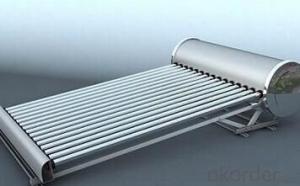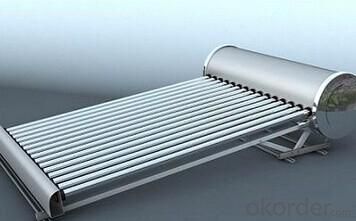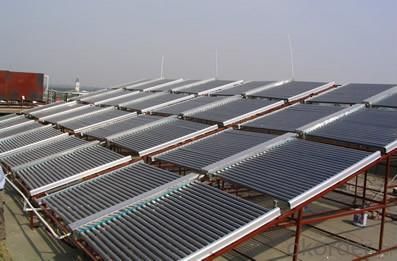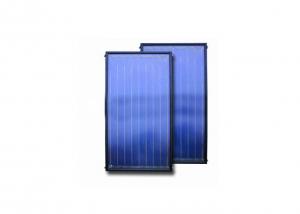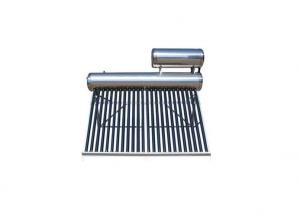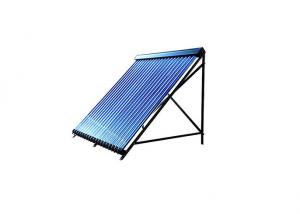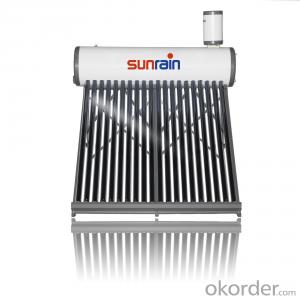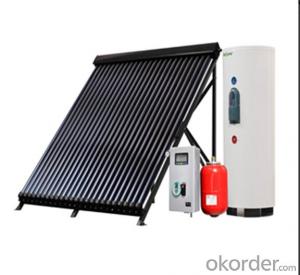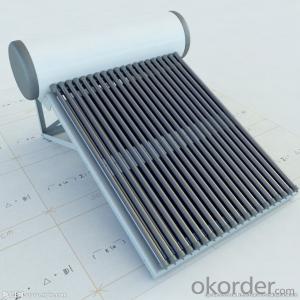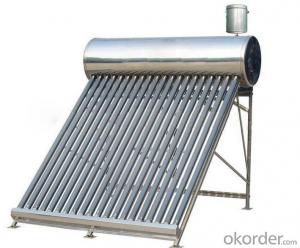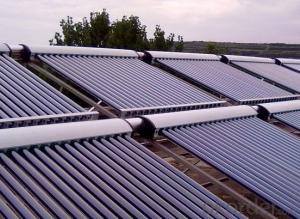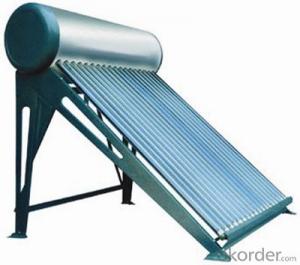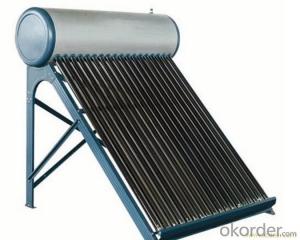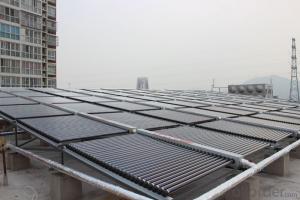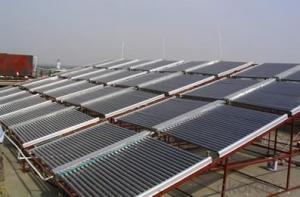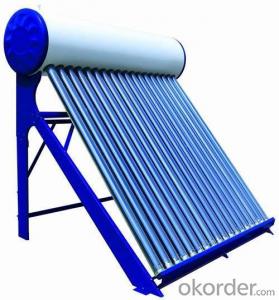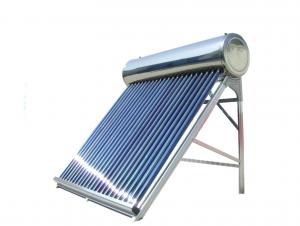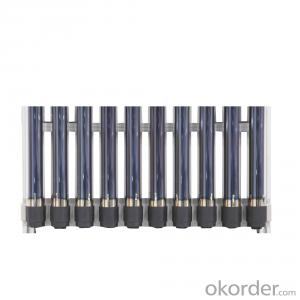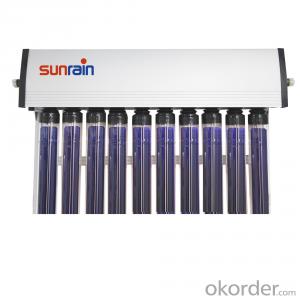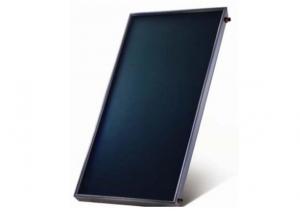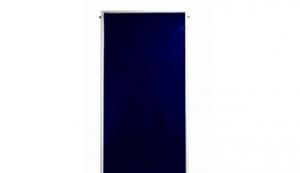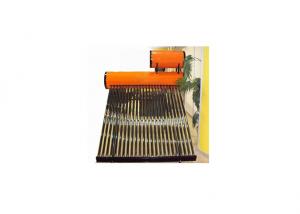150L Stainless Steel Solar Water Heater Prices
- Loading Port:
- Shanghai
- Payment Terms:
- TT OR LC
- Min Order Qty:
- 10 set
- Supply Capability:
- 5000 set/month
OKorder Service Pledge
OKorder Financial Service
You Might Also Like
Introduction of Non-Pressure Solar Water Heater:
Non-pressure Solar Heater is one of the most economical solar water heating device with pretty high efficiency at the same time. It consists of hot water storage tank, solar vacuum tubes with mouth plug in storage tank, and bracket supporting tank and tubes.When cold water in evacuated tubes is heated with solar irradiation, as the specific gravities of hot water and cold water are different, hotter water goes upward to storage tank and colder water goes downward to glass tubes. through this continuous circulation, the cold water in storage tank will be gradually heated till sunset.
Features:
1. High thermal performance and working temperature: the heat exchanging rate even in winter can up above 55%.
2. Heat collecting efficiency is at least 20% above common solar systems.
3. Work in all day and all season: no matter any corner of the world, this system can work well even -40℃ to avoid the tube freezing problem.
4. Reliability: No water following through the tube, so water scale can not generate and tube cracks could be avoided, the system still can keep working even with some damaged tubes.
5. It can connect with water tap and work automatically with pressure0.6Mpa, bring enjoyable washing experience.
6. Safety: P/T valve would release pressure and temperature to protect tank..
Specification
ITEM.NO | SPECIFICATION | EFFECTIVE LIGHT AREA | TANK'S CAPACITY | APPLICATION PEOPLE | CBM | |||
DIAMETER OF WATER TANK | QTY OF TUBE(pcs) | DIAMETER OF TUBE | LENGTH OF TUBE | |||||
Z-NS5810 | 460mm | 10 | 58mm | 1.8m | 1.04 | 100L | 4 | 0.37 |
Z-NS5812 | 460mm | 12 | 58mm | 1.8m | 1.25 | 120L | 4-5 | 0.44 |
Z-NS5815 | 460mm | 15 | 58mm | 1.8m | 1.56 | 150L | 6 | 0.56 |
Z-NS5818 | 460mm | 18 | 58mm | 1.8m | 1.87 | 180L | 7-8 | 0.64 |
Z-NS5820 | 460mm | 20 | 58mm | 1.8m | 2.08 | 200L | 8 | 0.7 |
Z-NS5825 | 460mm | 25 | 58mm | 1.8m | 2.61 | 250L | 10 | 0.89 |
Z-NS5830 | 460mm | 30 | 58mm | 1.8m | 3.13 | 300L | 12 | 1 |
Z-NS5836 | 460mm | 36 | 58mm | 1.8m | 3.75 | 360L | 14-15 | 1.3 |
Z-NS5840 | 460mm | 40 | 58mm | 1.8m | 4.17 | 400L | 16 | 1.4 |
Z-NS5845 | 460mm | 45 | 58mm | 1.8m | 4.69 | 450L | 18 | 1.6 |
Product Details Show:
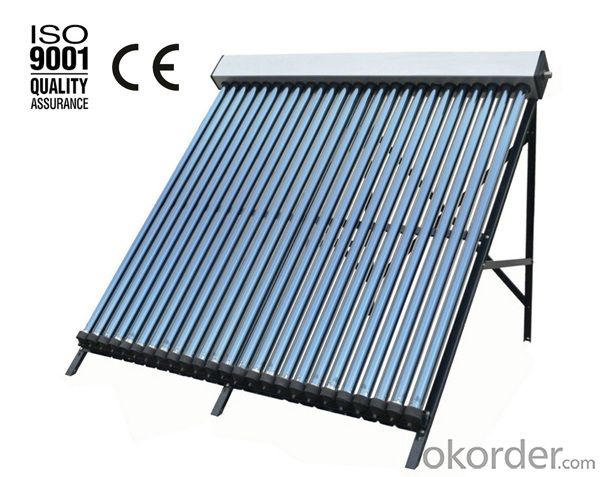
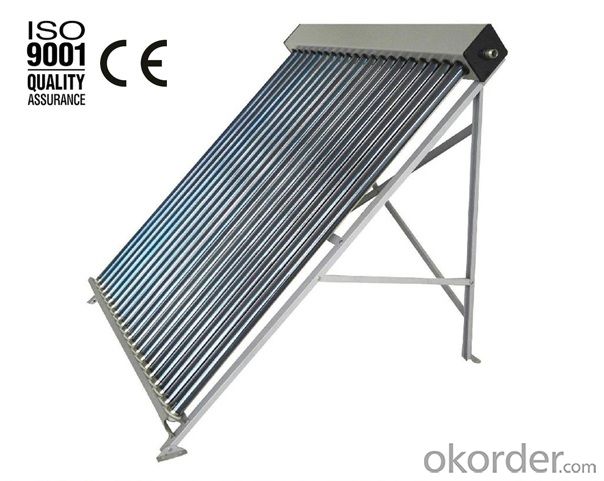
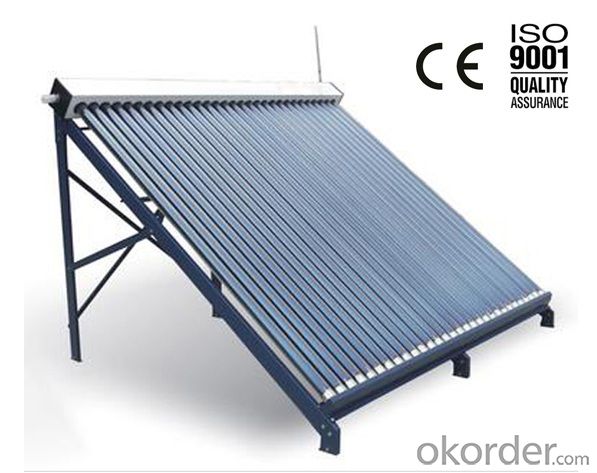
FAQ
1. Q: Are you a factory or trading company?
A: We are a factory. Especially for Solar Controller, PWM solar controller 50A12V/24V
2. Q: Where is your factory located? How can I visit there?
A: Our factory is located in Guangzhou, China. You are warmly welcomed to visit us!
3. Q: what other product you have except such Solar Lighting?
A: We have poly ,mono cells and panels. Off grid solar system, like off grid solar inverter, pure sine wave inverter, solar collector, solar controller, solar charger, Portal solar system, battery, DC Fan, Solar Led Light.
4. Q: Can the price be cheaper?
A: Of course, you will be offered a good discount for big amount.
5. How can I get a sample?
A: Please call us or send email for asking the samples.
- Q: Can a solar water heater be used in areas with limited access to hot water storage tanks?
- Yes, a solar water heater can be used in areas with limited access to hot water storage tanks. In such cases, alternative methods can be employed to store and distribute hot water generated by the solar water heater, such as using smaller individual storage tanks or implementing a direct circulation system where the heated water is immediately distributed to the desired location without the need for a storage tank.
- Q: Solar water heater can be used for a few years!That is, long life, high temperature
- Three, liner. At present, most of the solar water heater manufacturers said water tank is stainless steel. Stainless steel is the same, but chromium and nickel in stainless steel is not the same. Good solar water heater uses stainless steel high chromium nickel, ensure the liner durable, corrosion resistance is strong; much inferior liner using low grade stainless steel, basic does not contain nickel, corrosion resistance performance is poor, life is short.
- Q: Can a solar water heater be used in cold climates?
- Yes, a solar water heater can be used in cold climates. While the efficiency of a solar water heater may decrease in colder temperatures, they are specifically designed to operate in a wide range of climates. In cold climates, additional insulation and anti-freeze systems are usually incorporated to ensure the system functions optimally and prevents freezing.
- Q: Are there any government incentives or rebates for installing a solar water heater?
- Yes, there are government incentives and rebates available for installing a solar water heater. These incentives vary by country and region, but they often include tax credits, grants, and rebates that can help offset the installation costs and encourage the adoption of renewable energy technologies. It is recommended to check with local government agencies or energy departments to learn about specific incentives available in your area.
- Q: Can a solar water heater be used with an existing water heating system?
- Yes, a solar water heater can be used with an existing water heating system. It can work in conjunction with the existing system to supplement the heating process, reducing energy consumption and costs.
- Q: What is the expected performance of a solar water heater in different weather conditions?
- The expected performance of a solar water heater can vary in different weather conditions. In ideal conditions with clear skies and ample sunlight, the system will perform at its peak efficiency, providing hot water throughout the day. However, in cloudy or overcast weather, the performance may be reduced due to limited solar radiation. Similarly, during colder months or in areas with lower sunlight intensity, the heater's performance may be slightly lower compared to warmer and sunnier climates. Overall, while solar water heaters can still function and provide hot water in various weather conditions, their efficiency and output may be influenced by the amount of sunlight available.
- Q: What is the basic structure of solar water heater
- The basic structure of solar water heater consists of the following parts:1, the collector, the collector is the core component of solar energy is solar energy into thermal components, collector and vacuum tube type flat plate, vacuum tube collector with high efficiency, good resistance to decay, winter can produce hot water; weak anti thermal shock is poor, will Water Leakage embassy bombing flat type; anti thermal shock is strong, but the thermal efficiency is low, the winter is not good; the solar collector is the heart of Everfount provide hot water;
- Q: Can a solar water heater be used in areas with limited biofuel resources?
- Yes, a solar water heater can certainly be used in areas with limited biofuel resources. Solar water heaters rely on the energy from the sun to heat water, making them independent of biofuel resources. They are a sustainable and renewable alternative to traditional water heaters, making them a viable option in areas where biofuel resources are scarce or limited.
- Q: Overflow port leakage, but the computer controller water level has been shown full of water, what is the reason?
- The volume increases, so the water will flow out of the overflow. In this case, the meter will also be full of water. But the overflow pipe is not very fast
- Q: How does a solar water heater impact the electricity consumption of a household?
- A solar water heater can significantly reduce the electricity consumption of a household. By harnessing energy from the sun to heat water, it reduces or eliminates the need for using an electric water heater. This can lead to significant energy savings, lower electricity bills, and a reduced carbon footprint.
Send your message to us
150L Stainless Steel Solar Water Heater Prices
- Loading Port:
- Shanghai
- Payment Terms:
- TT OR LC
- Min Order Qty:
- 10 set
- Supply Capability:
- 5000 set/month
OKorder Service Pledge
OKorder Financial Service
Similar products
Hot products
Hot Searches
Related keywords
